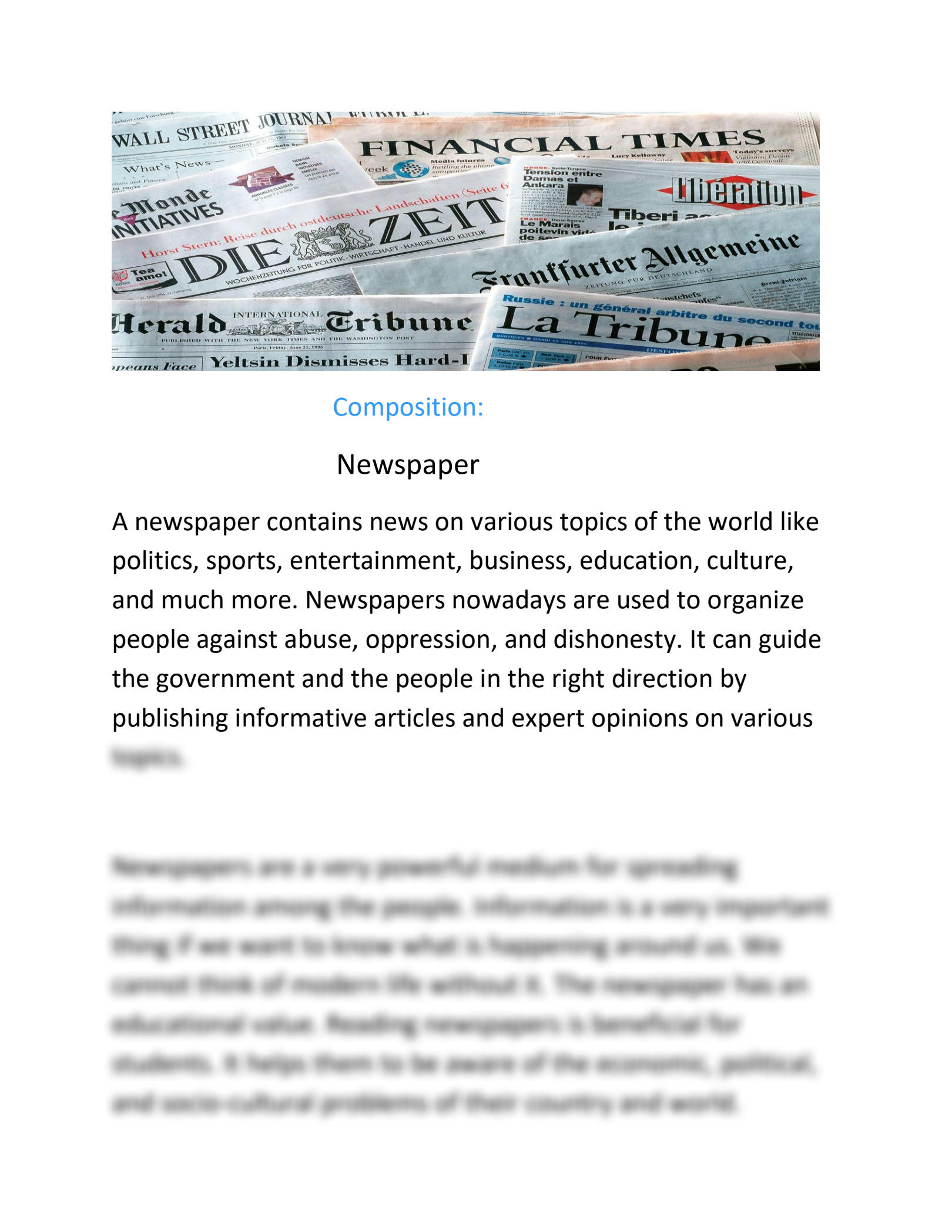A newspaper composition is a written piece that presents news, features, and opinion articles in a print or digital format. It aims to inform and engage readers with current events and diverse viewpoints.
Newspapers provide a platform for journalists to report on local and global issues, helping to shape public discourse and awareness in society. Additionally, newspapers often include sections such as sports, entertainment, and classified ads to cater to a wide range of reader interests.
With the evolution of online news platforms, newspapers continue to adapt to meet the changing needs of readers in the digital age.

Credit: www.studypool.com
The Evolution Of Newspapers
Newspapers have undergone a significant transformation over the years, with advancements in technology playing a crucial role in shaping their evolution. From the traditional print format to the digital landscape, newspapers have adapted to meet the changing needs of readers in the fast-paced digital age.
From Print To Digital
The transition from print newspapers to digital platforms marked a revolutionary shift in the way news is consumed. With the rise of the internet, newspapers embraced online publishing to reach a wider audience and stay relevant in the digital era.
Impact Of Technology
- Technology has revolutionized the way newspapers gather and disseminate information.
- Digital innovations have enabled real-time updates and interactive storytelling.
- Mobile apps and social media platforms have enhanced the reach and engagement of newspapers.
- Data analytics tools help newspapers understand reader preferences and tailor content accordingly.

Credit: www.vectorstock.com
Elements Of A Newspaper
When it comes to newspaper composition, understanding the elements that make up a newspaper is crucial for creating an engaging and informative publication. Each component plays a significant role in delivering the news effectively while capturing the reader’s attention. Let’s delve into the key elements of a newspaper and their functions.
Headline And Byline
The headline is a vital element of a newspaper as it provides a concise and attention-grabbing summary of the article. It should effectively convey the main point and entice readers to delve into the story. A compelling headline is often the first impression that drives readers’ interest in a particular article. Additionally, the byline identifies the author of the article, adding credibility and accountability to the content.
Articles And Columns
Newspapers consist of a myriad of articles and columns covering various topics such as news, opinion pieces, features, and more. Articles present factual information, while columns offer personal viewpoints and analysis. The diverse range of content ensures that newspapers cater to the different interests and preferences of their readers, providing a comprehensive source of information.
Images And Graphics
In addition to textual content, newspapers incorporate images and graphics to complement articles and capture readers’ attention. These visual elements not only enhance the aesthetic appeal of the publication but also provide context and convey information effectively. Well-chosen visuals can significantly impact the reader’s engagement and comprehension of the news.
The Role Of Journalism
Journalism plays a crucial role in our society by informing the public and providing them with unbiased and objective news. It serves as a powerful tool that helps people make well-informed decisions, promotes transparency, and holds those in power accountable.
Informing The Public
One of the main responsibilities of journalism is to inform the public about the events happening locally, nationally, and globally. Through well-written news articles, journalists bring important information to the forefront and ensure that people are aware of what is happening around them. By presenting the facts accurately and objectively, newspapers play a pivotal role in shaping public opinion and raising awareness about various issues.
Moreover, newspapers also serve as a platform where individuals and communities can voice their concerns, share their stories, and advocate for change. By providing a space for different perspectives, journalism fosters dialogue and encourages civic participation.
Investigative Reporting
Investigative reporting is another essential aspect of journalism. This form of reporting involves in-depth research and analysis to uncover hidden truths, expose corruption, and bring important issues to light. Investigative journalists often spend months or even years working on a single story, tirelessly digging for facts and evidence to support their claims.
In doing so, they serve as watchdogs for society, holding institutions and individuals accountable for their actions. Investigative reporting brings justice to the forefront, raises awareness of social ills, and helps bring about meaningful change in our communities.
By exposing scandals, abuses of power, and other injustices, investigative journalism plays a crucial role in maintaining transparency and preserving the principles of democracy.
Challenges In Modern Newspaper Composition
Creating a successful newspaper in the digital age comes with its fair share of challenges. As traditional print media continues to face competition from digital counterparts, maintaining credibility has become more important than ever. In this article, we will explore two key challenges that modern newspaper composition must confront: Competition from Digital Media and Maintaining Credibility.
Competition From Digital Media
The rise of digital media platforms has undoubtedly revolutionized the way news is consumed. With the advent of smartphones, tablets, and social media, users now have access to a vast array of information at their fingertips. This convenience and immediacy have led to a decline in traditional newspaper readership.
Online news outlets often utilize search engine optimization (SEO) techniques to increase their visibility on search engine result pages. This, coupled with the ability to share news articles through social media platforms, has given digital media a significant advantage in reaching a wider audience.
Furthermore, the quick and real-time nature of digital news has resulted in a decrease in print subscriptions. Readers now expect instant updates and the option to engage with news content through comments and sharing features. Newspaper publishers must adapt to these expectations by finding innovative ways to engage readers and stay relevant in the digital landscape.
Maintaining Credibility
Credibility is the cornerstone of any reputable newspaper. In an era where misinformation and fake news can spread like wildfire, maintaining trust is crucial. Newspapers have a responsibility to provide accurate and well-researched information to their readers.
One of the challenges in modern newspaper composition is verifying the authenticity of online sources. In the digital age, information can be easily manipulated and shared without proper fact-checking. This presents a dilemma for journalists and editors who need to navigate through the vast ocean of online content to find accurate and reliable sources.
Newspapers must invest in fact-checking and verification processes to ensure the credibility of their news stories. Additionally, transparent corrections and retractions when errors occur are essential for building trust with readers. By upholding high standards of journalism, newspapers can distinguish themselves from unreliable sources and maintain their credibility.
In conclusion, modern newspaper composition faces various challenges in the digital age. By acknowledging and adapting to the competition from digital media while remaining steadfast in maintaining credibility, newspapers can navigate these challenges and continue to provide valuable and reliable news to their audiences.
Strategies For Engaging Readers
When it comes to newspaper composition, engaging readers is a critical component. By implementing effective strategies, newspapers can captivate their audience and cultivate a loyal readership. Within the realm of engaging readers, two key strategies standout: interactive content and personalized recommendations. These tactics are essential for newspapers looking to create dynamic and engaging experiences for their readers.
Interactive Content
Newspapers can prioritize interactive content to enhance reader engagement. By incorporating elements such as quizzes, polls, and interactive multimedia, newspapers can create an immersive and participatory experience for their audience. Interactive content encourages readers to actively engage with the material, resulting in a more memorable and enjoyable reading experience. This approach not only captures the attention of readers but also fosters a sense of community and involvement within the newspaper’s audience.
Personalized Recommendations
Personalization is a key strategy for engaging readers, and newspapers can leverage this by providing personalized recommendations. By utilizing reader data and preferences, newspapers can offer tailored content suggestions to their audience. This approach not only enhances the reader’s experience by delivering content that aligns with their interests but also fosters a sense of connection and relevance. Personalized recommendations demonstrate a newspaper’s commitment to understanding and catering to the unique tastes and preferences of its readers, leading to increased engagement and loyalty.

Credit: in.pinterest.com
The Future Of Newspaper Composition
The evolution of newspaper composition is shifting towards digital formats, incorporating multimedia elements to enhance reader engagement. This transition reflects the industry’s adaptation to changing consumer preferences for interactive and dynamic news delivery, shaping the future of journalism.
The digital era has revolutionized newspaper composition. Embracing this change is crucial to ensuring the survival of traditional print media. Let’s delve into how newspaper composition is evolving in the face of technology.Adapting To Changing Trends
Incorporating multimedia elements like videos and interactive graphics is vital. Utilizing user-generated content fosters community engagement.Monetization Strategies
Diversifying revenue streams through online subscriptions and advertising partnerships is key. Developing personalized content helps retain loyal readers. By staying abreast of digital advancements, newspapers can navigate a dynamic landscape and thrive in the modern media environment.Frequently Asked Questions Of Newspaper Composition
How Is A Newspaper Article Composed?
A newspaper article is typically composed of a headline, lead, body, and conclusion. The headline captures the reader’s attention, while the lead offers a summary. The body provides more details, and the conclusion wraps up the article. This composition ensures a clear and engaging structure for news content.
What Are The Key Elements Of A Newspaper Composition?
Key elements of newspaper composition include the headline, byline, dateline, lead, body, and conclusion. The headline grabs attention, the byline attributes the article to the author, and the dateline indicates the place of reporting. The lead presents the main point, the body elaborates on it, and the conclusion summarizes the key takeaways.
How Long Should A Newspaper Article Be?
The length of a newspaper article varies depending on its topic and purpose. Generally, articles range from 300 to 800 words, although some can be longer. It’s important to maintain reader interest and provide sufficient information within the given word limit.
What Is The Role Of Images In A Newspaper Composition?
Images play a crucial role in newspaper composition by capturing readers’ attention and enhancing the visual appeal of an article. Relevant and eye-catching images can help convey the message effectively and break up blocks of text, resulting in a more engaging reading experience.
Conclusion
Newspapers play an essential role in transmitting information and shaping public opinion. With their diverse content and influential reach, newspapers continue to be a crucial source of news and analysis. By understanding the composition of newspapers, readers can better discern and evaluate the information presented to them.
Stay informed and engaged with the power of newspapers.








